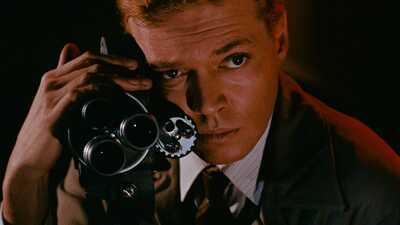Michael Powell has a cameo in “Peeping Tom.” He plays Mark’s father very briefly in that moment where he comes in front of the camera. I’m curious if you had conversations with him about the theme of this film and how filmmaking in and of itself can be destructive.
We didn’t talk too much about his films, interestingly. But Scorsese, of course, just talks endlessly about the subject of this film, which is that filmmaking becomes so addictive or can become so addictive that it can sometimes destroy you. You see an artist going through that, not a filmmaker. But like Moira Shearer in “The Red Shoes,” her life is being affected that way. As a filmmaker myself, I have to tell you, when we’re working on a film with him, he’s so amazing, and the work is so wonderful, and you end up working very, very long hours. That means your family doesn’t see you or your friends don’t see you. Sometimes, your health can suffer, but it’s because you are so gripped by what you’re doing, and you want to make it right and get it up on the screen. It can be very addictive.
Clearly, Michael Powell was a huge influence on Scorsese. Having seen both men’s work quite a bit, do you ever see any visual references to Powell’s work in Martin Scorsese’s movies?
Oh yes, he sometimes is inspired by a particular shot or sequence, but he never mimics it. A lot of people mimic Alfred Hitchcock. That’s not the way Marty was being influenced by Powell’s films. He would be terribly influenced by something, and something would show up in his movies that has nothing to do with how Michael used a shot. For example, in “After Hours,” when the man is riding downtown in a terrifying taxicab ride, and the $20 bill, the only money he has for the night, flies out the window. The inspiration for the way Scorsese shot that $20 bill slowly fading to the street was inspired by the wedding dress hanging in the train in “I Know Where I’m Going.” when Joan is on her way up to Scotland, she thinks of marrying a rich man, which doesn’t turn out that way. So, you can see that a wedding dress just hanging and swinging inspired that shot of the $20 bill.
There are several other instances of that, but mainly, I think he was just so inspired by the daring and innovative way that Michael and Emeric made movies. Of course, Emeric had nothing to do with this movie, but he [Scorsese] was so inspired by the fact that they were never interested in heroes or villains. They were more interested in the people in between and [in] the gray area. So, he instantly responded to that, even when he was very young.
Having grown up in a mafia neighborhood, he certainly saw evil men and experienced them as human beings. I mean, one of the mafia chieftains on his street would take the kids living in the tenements. It was hot during the summer in New York, and he would take them all out to a lake so they could swim in New Jersey. He saw that side as well, as he didn’t really know how bad the other side was. Still, he was aware of the fact that you can sometimes see a person who might not be the best kind of person you want someone to be, but you can come to understand him and feel some sympathy for him, which is what you see with Jake LaMotta, for example, in “Raging Bull.” This was something that he felt that Michael Powell also shared an interest in people who were not good or evil, but something in between.

